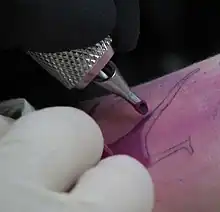
The process or technique of tattooing, creating a tattoo, involves the insertion of pigment (via tattoo ink) into the skin's dermis. Traditionally, tattooing often involved rubbing pigment into cuts. Modern tattooing almost always requires the use of a tattoo machine and often procedures and accessories to reduce the risk to human health.
Physiological process of tattooing
Tattooing involves the placement of pigment into the skin's dermis, the layer of dermal tissue underlying the epidermis. After initial injection, pigment is dispersed throughout a homogenized damaged layer down through the epidermis and upper dermis, in both of which the presence of foreign material activates the immune system's phagocytes to engulf the pigment particles. As healing proceeds, the damaged epidermis flakes away (eliminating surface pigment) while deeper in the skin granulation tissue forms, which is later converted to connective tissue by collagen growth. This mends the upper dermis, where pigment remains trapped within fibroblasts, ultimately concentrating in a layer just below the dermis/epidermis boundary. Its presence there is stable, but in the long term (decades) the pigment tends to migrate deeper into the dermis, accounting for the degraded detail of old tattoos.[1]
Traditional tattooing

Some tribal cultures traditionally created tattoos by cutting designs into the skin and rubbing the resulting wound with ink, ashes or other agents; some cultures continue this practice, which may be an adjunct to scarification. Some cultures create tattooed marks by hand-tapping the ink into the skin using sharpened sticks or animal bones (made like needles) with clay formed disks or, in modern times, needles. Traditional Japanese tattoos (irezumi) are still "hand-poked", that is, the ink is inserted beneath the skin using non-electrical, hand-made and hand held tools with needles of sharpened bamboo or steel. This method is known as tebori.
Traditional Hawaiian hand-tapped tattoos are experiencing a renaissance, after the practice was nearly extinguished in the years following Western contact. The process involves lengthy protocols and prayers and is considered a sacred rite more than an application of artwork. The tattooist chooses the design, rather than the wearer, based on genealogical information. Each design is symbolic of the wearer's personal responsibility and role in the community. Tools are hand-carved from bone or tusk without the use of metal.[2]
Modern tattooing

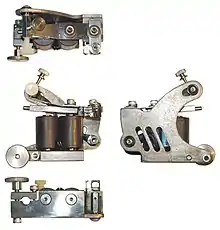
The most common method of tattooing in modern times is the electric tattoo machine, which inserts ink into the skin via a single needle or a group of needles that are soldered onto a bar, which is attached to an oscillating unit. The unit rapidly and repeatedly drives the needles in and out of the skin, usually 80 to 150 times a second. This modern procedure is ordinarily sanitary. The needles are single-use needles that come packaged individually. The tattoo artist must wash his or her hands and must also wash the area that will be tattooed. Gloves must be worn at all times and the wound must be wiped frequently with a wet disposable towel of some kind. The equipment must be sterilized in a certified autoclave before and after every use.
Prices for this service vary widely globally and locally, depending on the complexity of the tattoo, the skill and expertise of the artist, the attitude of the customer, the costs of running a business, the economics of supply and demand, etc. The time it takes to get a tattoo is in proportion with its size and complexity. A small one of simple design might take 15 minutes, whereas an elaborate sleeve tattoo or back piece requires multiple sessions that may consist of several hours at a time ranging over months or even years.
In 1891 the first electric tattoo needle was patented in New York City by Samuel O'Reilly, who modified Thomas Edison's electric engraving pen.[3] O'Reilly's machine was based on the rotary technology of the electric engraving device invented by Thomas Edison.[4] Modern tattoo machines use electromagnetic coils. Another early tattoo machine, with an electromagnetic coil, was patented by Sutherland MacDonald in 1894.[3] The first twin-coil machine, the predecessor of the modern configuration, was invented by another Englishman, Alfred Charles South of London, in 1899. The rotary tattoo machine was developed from 1974 to 1978 by the German tattoo artists Horst Heinrich Streckenbach (1929–2001) and Manfred Kohrs.[5]
Permanent makeup
Permanent makeup or semi-permanent makeup tattoos are cosmetic tattoos that are meant to alter pigmentation in the facial features. Some types of permanent makeup are used for medical conditions, such as to cover up scars or vitiligo,[6] while other types are simply for aesthetic reasons like tattooing eyeliner, lip color or eyebrows. The pigment is inserted into the surface of the skin in patterns to be able to cover the desired areas.
Permanent makeup is typically done with some form of tattoo machine. There are machines now that are needle-less which should result in less painful procedures. These needle-free devices are considered safer and more sterile to use than traditional tattoo machines. They are designed to create a more comforting experience during the application process and eliminate the possibility of spreading disease like HIV, hepatitis and other healthcare issues.[7] The needle-less device is also capable of inserting the pigment deeper into the skin than machines that use needles.
There are several different ways to get rid of these tattoos, the most common being laser removals. It is suggested that different color pigments should be removed with different lasers in order to reduce the risk of scarring and ink retention. The needle-free machines also have the capability of removing or lightening the pigment from the skin as well by adding in a removal solution into the skin.[7]
Permanent makeup or micropigmentation is much like any tattoo and can have side effects over time. Infections, fading, scarring, inflammation, and allergic reactions are just a few of the side effects that have been reported from patients who received permanent makeup procedures.[8]
Nipple-areola Tattoos
Tattoos have also made an entrance into the medical field. Nipple-areola tattoos are a form of medical tattoos that can be done for those who lost their nipple during a mastectomy and had breast reconstruction surgery. The tattoo artist tries to recreate the same pigment and shape as the original nipple and areola, although it may not always result in an exact replica as the patient’s old nipple. The tattoo may not be the exact or desired shade of the nipple that the patient originally had because the artist may make the tattoo a bit darker in order for the tattoo to lighten up over time, ultimately resulting in the correct shade.[9] The machine that is used during the procedure will also affect the color that the tattoo has and how the pigment will react with the skin.[10]
Not all nipple-areola tattoos are successful. There is a chance that the tattoo could get infected just as any tattoo can. In a study from 1988—1993 of 103 patients who received nipple-areola tattoos, 5 patients reported getting an infection, 1 patient reported getting a rash, one reported getting slough, and 19 patients had to have their tattoo touched up due to the pigment diminishing from the tattoo through the healing process.[10]
Nipple-areola tattoos tend to be one of the final steps to breast reconstruction surgery. In the study of those who received the tattoos, 86% said that they would get the procedure done again if they needed to.[10]
Dyes and pigments
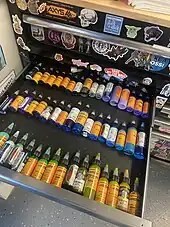
Early tattoo inks were obtained directly from nature and were extremely limited in pigment variety. In ancient Hawaii, for example, kukui nut ash was blended with coconut oil to produce an ebony ink.[2] Today, an almost unlimited number of colors and shades of tattoo ink are mass-produced and sold to parlors worldwide. Tattoo artists commonly mix these inks to create their own unique pigments.
A wide range of dyes and pigments can be used in tattoos, from inorganic materials like titanium dioxide and iron oxides to carbon black, azo dyes, and acridine, quinoline, phthalocyanine and naphthol derivatives, dyes made from ash, and other mixtures. Iron oxide pigments are used in greater extent in cosmetic tattooing.
Modern tattooing inks are carbon-based pigments that have uses outside of commercial tattoo applications.
Concern has been expressed[11] over the interaction between magnetic resonance imaging (MRI) procedures and tattoo pigments, some of which contain trace metals. The magnetic fields produced by MRI machines interact with these metals, including nonferrous metal particles, and while rare, are capable of causing first-degree or second-degree burns[12] or distortions in the image. The type and density of the ink as well as shape of the tattoo may increase the risk, particularly if the shape approximates an RF pick-up loop.[13] The television show MythBusters tested the hypothesis, and found a slight interaction between commonly used tattoo inks and MRI. The interaction was stronger with inks containing high levels of iron oxide.[14]
Studio hygiene
Procedures
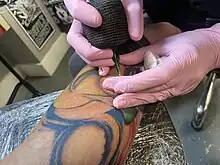
The properly equipped tattoo studio will use biohazard containers for objects that have come into contact with blood or bodily fluids, sharps containers for old needles, and an autoclave for sterilizing tools. Certain jurisdictions also require studios by law to have a sink in the work area supplied with both hot and cold water.
Proper hygiene requires a body modification artist to wash his or her hands before starting to prepare a client for the stencil, between clients, and at any other time when cross contamination can occur. The use of single use gloves is also mandatory and disposed after each stage of tattooing. The same gloves should not be used to clean the tattoo station, tattoo the client, and clean the tattoo.
In some states and countries it is illegal to tattoo a minor even with parental consent, and (except in the case of medical tattoos) it is forbidden to tattoo impaired persons, people with contraindicated skin conditions, those who are pregnant or nursing, those incapable of consent due to mental incapacity, or those under the influence of alcohol or other drugs.
Before the tattooing begins the client is asked to approve the final position of the applied stencil. After approval is given the artist will open new, sterile needle packages in front of the client, and always use new, sterile, or sterile disposable instruments and supplies, and fresh ink for each session (loaded into disposable ink caps which are discarded after each client). Also, all areas which may be touched with contaminated gloves will be wrapped in clear plastic to prevent cross-contamination. Equipment that cannot be autoclaved (such as counter tops, machines, and furniture) will be wiped with an approved disinfectant.[15]
Incentives for continuing education
Membership in professional organizations or certificates of appreciation/achievement generally help artists to be aware of the latest trends. Most tattooists do not belong to any association.
Training and certification requirements
While specific requirements to become a tattooist vary between jurisdictions, many mandate only formal training in blood borne pathogens and cross contamination. The local department of health regulates tattoo studios in many jurisdictions. For example, according to the health departments in Oregon and Hawaii, tattoo artists in these states are required to take and pass a test ascertaining their knowledge of health and safety precautions as well as the current state regulations. Performing a tattoo in Oregon without a proper and current license or in an unlicensed facility is a felony offense. Tattooing was legalized in New York City in 1997,[16] in Massachusetts in 2000[17] and Oklahoma between 2002 and 2006.
Aftercare
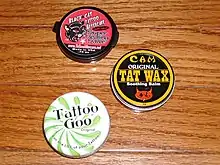
Tattoo artists and people with tattoos vary widely in their preferred methods of caring for new tattoos. Some artists recommend keeping a new tattoo wrapped for the first 24 hours while others suggest removing temporary bandaging after two hours or less to allow the skin to breathe. Many tattooists advise against allowing too much contact with hot tub, pool water or soaking in a tub for the first two weeks to prevent the tattoo ink from washing out. In contrast other artists suggest that a new tattoo be bathed in very hot water early.
General consensus for care advises against removing the flakes or scab that may form on a new tattoo, and avoiding exposing a new tattoo to the sun for extended periods for at least three weeks; both of these can contribute to fading of the image. It is agreed that a new tattoo needs to be kept clean. Various products may be recommended for application to the skin, ranging from those intended for the treatment of cuts, burns and scrapes, to panthenol, cocoa butter, A&D, hemp, lanolin, or salves.[18] Oil based ointments are almost always recommended for use on very thin layers due to their inability to evaporate and therefore over-hydrate the already perforated skin. Recent scientific studies have demonstrated that wounds that are kept moist heal faster than wounds healing under dry conditions.[19] In recent years specific commercial products have been developed for tattoo aftercare. Although opinions about these products vary, soap and warm water work well to keep a tattoo clean and free from infection.[20] It is advised that fragrance-free soaps and soaps that contain alcohol not be used to clean the tattoo to avoid burning or drying out the tattoo too quickly. Try to avoid loofahs and unwashed clothes which both can contain bacteria that could get into the tattoo and cause an infection. The best way to dry your tattoo is to use a paper towel as regular towels may also contain bacteria, even if they are just washed. [21]
The amount of ink that remains in the skin throughout the healing process determines how the final tattoo will look. If a tattoo becomes infected or the flakes fall off too soon (e.g., if it absorbs too much water and sloughs off early or is picked or scraped off) then the ink will not be properly fixed in the skin and the final image will be negatively affected. [22]
Regulations
France has had hygiene regulations for tattooing and piercing since 2008[23][24]. On March 6, 2013, France banned the use of nine common color tattoo inks, including red, orange, and yellow pigments. The ban took effect on January 1, 2014.[25] Tattoo artists in France must comply with the hygiene and safety regulations of the National Health Security Agency (ANSM). If they violate the regulations, they can be fined up to €1,500.[26][27]
The European Union banned the use of 25 red, orange, and yellow color tattoo inks on January 4, 2022[28][29][30]. The ban on the Blue 15:3 and Green 7 pigments is scheduled to take effect in 2023[31][32].
Vietnam still considers tattoos to be a sensitive issue and has many restrictive regulations.[33][34] According to Vietnamese law, tattoos are not completely banned.[35][36][37] However, there are some cases in which tattoos are not allowed, including: People under the age of 18, people with mental illness or other conditions that could affect the tattoo, people who are currently serving a prison sentence.
In the United States there is no federal law regulating the practice of tattooing.[38] However, all 50 states and the District of Columbia have statutory laws requiring a person receiving a tattoo be at least 18 years old. This is partially based on the legal principle that a minor cannot enter into a legal contract or otherwise render informed consent for a procedure. Most states permit a person under the age of 18 to receive a tattoo with permission of a parent or guardian, but some states prohibit tattooing under a certain age regardless of permission, with the exception of medical necessity (such as markings placed for radiation therapy).
References
- ↑ Tattoo lasers / Histology, Suzanne Kilmer, eMedicine
- 1 2 "Marked" Archived 2011-07-12 at the Wayback Machine Article by Shannon Wianecki in Maui No Ka 'Oi Magazine, Vol.15 No. 4 July 2011
- 1 2 Nyssen, Carmen Forquer (October 5, 2015). "Early Tinkerers of Electric Tattooing". Buzzworthy Tattoo History. Retrieved 2022-06-05.
- ↑ "Tattoo". The Hutchinson Unabridged Encyclopedia with Atlas and Weather Guide (Credo Reference. Web. ed.). Helicon: Abington. 17 September 2012.
- ↑ Vgl. Marcel Feige, Das Tattoo-und Piercing Lexikon, S. 282, ISBN 3-89602-209-1
- ↑ De Cuyper, Christa (2008). "Permanent Makeup: Indications and Complications". Clinics in Dermatology. 26 (1): 30–34. doi:10.1016/j.clindermatol.2007.10.009. ISSN 0738-081X. PMID 18280902.
- 1 2 US 6689095, Garitano, Gilbert & Garitano, Linda, "Needleless permanent makeup and tattoo device", published 2004-02-10
- ↑ Wollina, U.; Goldman, A. (2014). "Severe unexpected adverse effects after permanent eye makeup and their management by Q-switched Nd:YAG laser". Clinical Interventions in Aging. 9: 1305–1309. doi:10.2147/CIA.S67167. ISSN 1178-1998. PMC 4136952. PMID 25143716.
- ↑ Spear, Scott L.; Convit, Rafael; Little, John W. III (1989). "Intradermal Tattoo as an Adjunct to Nipple-Areola Reconstruction". Plastic and Reconstructive Surgery. 83 (5): 907–11. doi:10.1097/00006534-198905000-00027. ISSN 0032-1052. PMID 2710843.
- 1 2 3 Spear, Scott; Arias, Joanna (1995-09-01). "Long-Term Experience with Nipple-Areola Tattooing". Annals of Plastic Surgery. 35 (3): 232–236. doi:10.1097/00000637-199509000-00002. ISSN 0148-7043. PMID 7503514. S2CID 38198746.
- ↑ Glenn D. Braunstein, M.D. (31 October 2011). "Tattos: Inks Raise New Health Concerns About Age-Old Designs". huffingtonpost.com.
- ↑ Franiel T, Schmidt S, Kligebiel R (November 2006). "First-Degree Burns on MRI due to Nonferrous Tattoos". AJR Am J Roentgenol. 187 (5): W556. doi:10.2214/AJR.06.5082. PMID 17056894.
- ↑ Wagle William A; Smith Martin (2000). "Tattoo-induced skin burn during MR imaging". AJR Am J Roentgenol. 174 (6): 1795. doi:10.2214/ajr.174.6.1741795. PMID 10845532.
- ↑ Karen L. Hudson. "Tattoos and MRI Scans". about.com.
- ↑ Renee Kottenhahn. "Tattoos: Safe Tattooing". TeensHealth.
- ↑ "Legalizing Tattoos". NYC24. 2003-04-04. Archived from the original on 2010-06-20. Retrieved 2012-08-03.
- ↑ "Massachusetts Tattooing Ban Declared Unconstitutional". ACLU. 2000-10-23. Retrieved 2015-09-22.
- ↑ "Tattoo Aftercare - How to Care for Your New Tattoo - Detailed Instructions and Product Information". Tattoo.about.com. 2012-03-27. Retrieved 2012-04-05.
- ↑ "The Definitive Tattoo Aftercare Guide". Dr. Jason K. Rivers, MD, FRCPC, DABD, FAAD (Dermatologist). Retrieved 2014-03-19.
- ↑ "Tattoo Post Operative Care". Thetattoocollection.com. Retrieved 2012-04-05.
- ↑ "Living Canvas Tattoo, Body Piercing & Art Gallery Columbia Missouri, 65201". Retrieved 2019-05-05.
- ↑ "The ultimate tattoo aftercare guide by a professional tattoo artist". 10 April 2022. Retrieved 2022-06-01.
- ↑ "Décret n° 2008-149 du 19 février 2008 fixant les conditions d'hygiène et de salubrité relatives aux pratiques du tatouage avec effraction cutanée et du perçage, et modifiant le code de la santé publique (dispositions réglementaires) - Légifrance". www.legifrance.gouv.fr. Retrieved 2024-01-10.
- ↑ "Décret n° 2008-149 du 19 février 2008". www.legifrance.gouv.fr. Retrieved 2024-01-10.
- ↑ "Tatouage: pourquoi les encres de couleur seront bientôt interdites". L'Express (in French). 2013-11-27. Retrieved 2024-01-10.
- ↑ "Décret n° 2008-149 du 19 février 2008". www.legifrance.gouv.fr. Retrieved 2024-01-10.
- ↑ Arrêté du 3 décembre 2008, retrieved 2024-01-10
- ↑ Maïwenn Furic (9 December 2021). "Tatouage : des encres interdites dès 2022 par l'Union européenne, les professionnels voient rouge". 20 Minutes..
- ↑ VTV, BAO DIEN TU (2022-01-05). "EU cấm sử dụng mực màu xăm có nguy cơ gây bệnh ung thư". BAO DIEN TU VTV (in Vietnamese). Retrieved 2024-01-10.
- ↑ baotintuc.vn (2022-01-05). "EU cấm sử dụng mực màu xăm có nguy cơ gây bệnh ung thư". baotintuc.vn (in Vietnamese). Retrieved 2024-01-10.
- ↑ Dominique Guillot (29 September 2021). "Tatouage : des encres interdites dès 2022 par l'Union européenne, les professionnels voient rouge". Ouest-France..
- ↑ ONLINE, TUOI TRE (2022-01-05). "Tiệm xăm châu Âu náo loạn vì hết mực". TUOI TRE ONLINE (in Vietnamese). Retrieved 2024-01-10.
- ↑ "Hình xăm dưới góc nhìn văn hóa: Lựa chọn nào cũng có sự đánh đổi". Báo điện tử Tiền Phong (in Vietnamese). 2021-10-02. Retrieved 2024-01-10.
- ↑ "Dân chơi Hà Thành đổ xô đi xăm trổ (kỳ 2)". Giáo dục Việt Nam (in Vietnamese). 2012-04-05. Retrieved 2024-01-10.
- ↑ "Nghiên cứu quy định cụ thể về hình xăm trên cơ thể, chống lợi dụng để trốn tránh nghĩa vụ quân sự | Tạp chí Điện tử Luật sư Việt Nam". lsvn.vn (in Vietnamese). Retrieved 2024-01-10.
- ↑ Trần, Lành. "Học phun xăm". Retrieved 2024-01-10.
- ↑ "Xăm hình có được miễn tham gia nghĩa vụ quân sự không?". qdnd.vn. Retrieved 2024-01-10.
- ↑ Farley, Cindy L.; Hoover, Cheri; Rademeyer, Carol-Ann (26 February 2019). "Women and Tattoos: Fashion, Meaning, and Implications for Health". Journal of Midwifery & Women's Health. 64 (2): 154–169. doi:10.1111/jmwh.12932. eISSN 1542-2011. ISSN 1526-9523. PMID 30806488. S2CID 73502073.